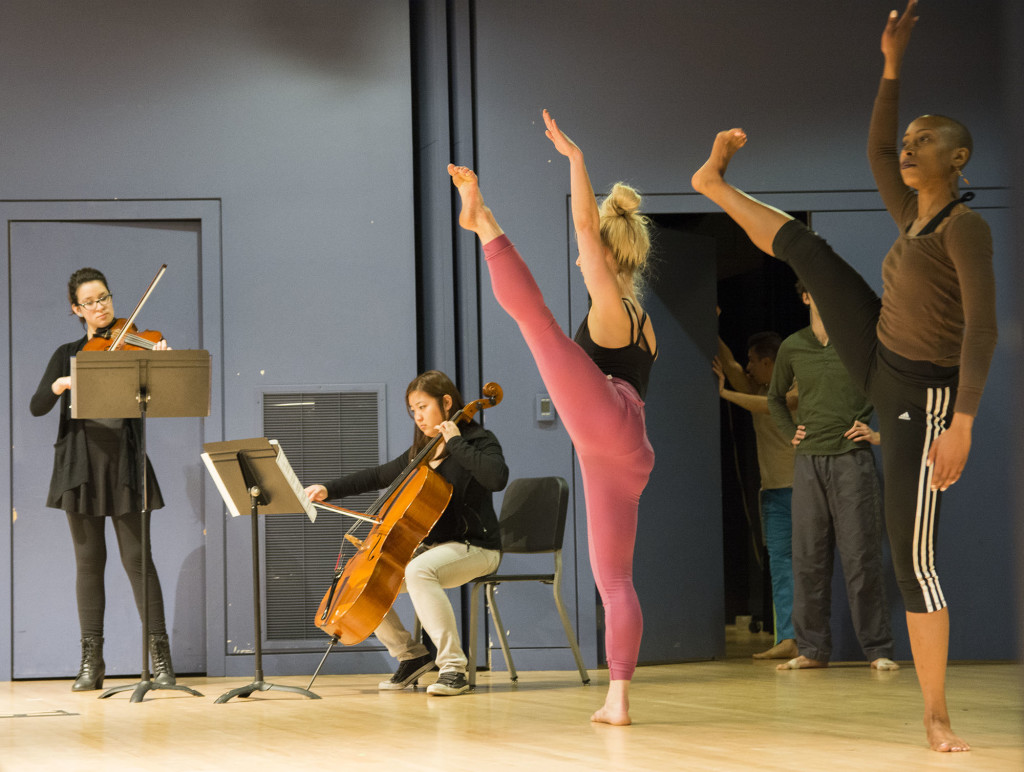The term “classical music” immediately brings to mind names like Bach, Beethoven and Mozart, but this year’s Seattle University Winter Chamber Music Concert will showcase pieces from lesser known contemporary composers.
It will also mark the first time Seattle U collaborates with a professional choreographer and professional dancers for a performance. Donald Byrd, a choreographer from Spectrum Dance Theater here in Seattle, will have his dancers performing onstage alongside Seattle U students, making for a musically and visually powerful show.
Chamber Music Director Quinton Morris said he is excited that his students have this opportunity to work with Byrd and his dancers.

Violist Chyna Mapel and cellist Dahae Cheong rehearse their duet by Walter Piston with dancers from Seattle’s Spectrum Dance Theatre.
“This is more of a non-traditional approach to chamber music,” Morris said. “My hope is that my students who graduate and move on will remember this experience and look at it as one that was really life-changing for them, in the sense of daring them to be more creative and expressive.”
Morris first met Byrd in 2011 when they were the only two individuals to receive the Seattle Mayor’s Arts Award that year. Then in 2013, the two performed together at the opening of a sculpture installation for the Seattle Art Museum. It was just the two of them—violinist and dancer side by side—and it was such a hit that it inspired them to work toward an even bigger collaboration.
“We had such a great performance that we always said we should collaborate and do something else together,” Morris said. “And wouldn’t it be cool if we did it with our students? So that’s how it came to be.”
The performance will include music ranging from the 1700s to the 1900s that differs from what Morris’s students are accustomed to playing. Pianist Shea O’Malley will play a four-hand piece—a duet played on one piano—with his partner pianist Maggie Molloy. The piece was written by the influential 20th century composer Igor Stravinsky. This is O’Malley’s first time playing a four-hand, and he said his biggest challenge has been getting used to Stravinsky’s unusual rhythms.
“It’s a new kind of genre of music that I haven’t worked with a ton before, so I’m excited to take on the challenge,” O’Malley said. “We’re all working on interesting, more modern pieces right now, which is really cool.”
Performing contemporary musical works is a bit of a rarity in the United States, and Seattle is one of the few major cities in America to be bringing more attention to contemporary composers. Morris said he decided to use these more unusual pieces for this quarter’s show in order to make his students aware of music that might not be as well known, but that is still relevant in musical history.
“I hope my students really gain and grow from this experience, not only as musicians, but as people,” Morris said. “And I hope the audience experiences art in a new and different way.”
On top of showcasing unique pieces of music, Morris hopes the show will also be memorable for its visual impact. Not only will the audience be listening to the music, they’ll also be watching how the music influences the movements of the dancers.
“I think it might help people hear the music differently, based on how the dancers interpret it,” said violinist Milena Marlier. “It’s kind of a more visual representation of what’s going on with the music.”
Students hope this concert will be the first of many times Seattle U hosts a multimedia performance.
“It’s a really unique opportunity, and I’m just excited to perform in general,” O’Malley said. “I hope we put on a really engaging performance for the audience and I hope they get as lost as we do in the music.”
Morris said he hopes attendees will leave wanting to make music themselves.
“I hope that this inspires people to come and support our students for more concerts,” Morris said. “I hope it also inspires people who might have played an instrument at one point to pick that instrument back up.”
The concert is this Thursday, March 12 at 7:30 p.m. in Pigott Auditorium. Tickets are $5 for students, $8 for faculty and staff and $10 for the general public.
Maggie Molloy is the A&E Editor of the Spectator.








